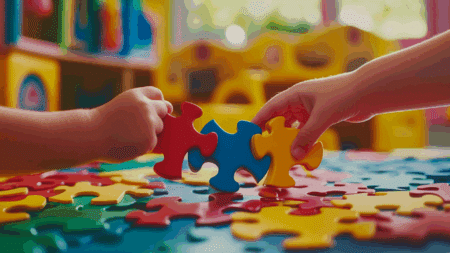Managing emotions can be tough for young children, especially in a busy preschool environment.
A Chill Spot provides a calm and safe space for kids to relax, process their emotions, and regain control.
This blog will teach you how to set up a Chill Spot in your classroom or home, offering kids a peaceful retreat when they’re feeling overwhelmed.
With tools like breathing exercises, sensory bottles, and calming activities, children can learn to manage their feelings in a supportive and good environment.
Creating this space helps build emotional resilience, teaching kids how to handle tough situations and develop vital social-emotional skills.
What is a Chill Spot?
A Chill Spot is a dedicated area in a classroom or home where preschoolers can go when they feel upset, angry, or too excited.
It’s a comfortable, quiet corner with soft cushions, calming toys, and simple tools that help young children learn to manage their feelings.
Unlike a time-out area for punishment, a Chill Spot is a positive space where kids choose to go when they need a break to calm down and sort through their emotions.
The space typically includes items like stress balls, breathing cards with simple instructions, emotion charts, and soft toys that help children express and process their feelings in healthy ways.
Benefits of Emotional Regulation in Preschoolers
Emotional regulation skills help preschoolers develop important life skills that support their growth now and in the future.
Children who recognize and control their emotions tend to make friends more easily and experience fewer behavior problems in school.
Better focus and the ability to follow directions are benefits of emotional regulation, improving learning activities.
Research shows that children who practice emotional regulation become better problem-solvers and show more patience in challenging situations.
These early skills form a strong foundation for mental health, reducing anxiety as children progress through their school years.
How to Set Up a Chill Spot in Your Classroom

Choosing the Right Location
Pick a quiet corner away from high-traffic areas and distractions. The ideal Chill Spot should be partly secluded but still visible from your teaching position for safety.
A space against a wall or in a corner works well as it provides boundaries that help children feel secure. Consider using a small tent, room divider, or bookshelf to create a sense of privacy.
Make sure the area is big enough for 1-2 children but small enough to feel cozy and safe. Good lighting matters, too. Aim for soft, calm lighting rather than harsh fluorescents.
The Tools You’ll Need
Stock your Chill Spot with tools that help children manage their emotions. Include breathing guides with simple drawings showing deep breaths in and out.
Add sensory bottles filled with colored water and glitter that children can shake and watch settle. Provide a few quality fidget toys, such as stress balls, stretchy items, or textured objects.
Include a feelings chart with simple faces showing different emotions. Add a small timer to help with transitions. Include a few soft pillows or stuffed animals for comfort.
Consider adding headphones and simple picture books about feelings.
Keeping it Organized
Use clear visual systems to help children use the Chill Spot properly. Label each item with both words and simple drawings so pre-readers can find what they need.
Create a small chart showing how many students can use the area at once (usually 1-2). Make small picture cards that show how to use each tool correctly.
Add a “How Do I Feel?” chart at the child’s height so kids can point to their emotions. Create a simple step-by-step guide showing how to return items to their correct spots.
Consider using color-coded baskets for different types of calming tools.
Teaching Children to Use the Chill Spot
Introducing the Chill Spot to Your Class
Gather the children in a circle near the Chill Spot. Explain that it’s a special place to go when feeling upset or too excited. Show each tool and its purpose.
Ask children what makes them feel better when upset. Have them name feelings they might have when they need the spot.
End with a simple tour where each child can see and touch the items while you supervise.
Modeling Emotional Regulation
Act out feeling frustrated, then say, “I need to calm down.” Walk to the Chill Spot. Show taking deep breaths with a breathing card.
Use a sensory bottle, watch the glitter fall. Squeeze a stress ball while counting to five. Say, “I feel better now,” and return to class.
Repeat this scene often during the first weeks. Praise children when they copy these steps.
Setting Ground Rules
Create simple rules with the class: “We walk to the Chill Spot,” “We use quiet voices,” and “We handle tools with care.”
Make a visual chart showing these rules. Explain that a maximum of two children can use the spot at once. Set a five-minute timer for turns.
Remind children that the spot is for calming down, not for play or hiding. Review these guidelines weekly.
Practical Tools for the Chill Spot
Breathing Exercises: Calm Breathing for Kids

Teaching children deep breathing is like showing them a secret superpower to manage big feelings.
Start with fun, animal-inspired breaths: imagine breathing like a sleepy bear, a playful puppy, or a gentle butterfly.
Practice together, making it a game where kids can feel their bodies relax and their minds become peaceful.
Sensory Bottles and Fidget Toys: Helpful Helpers

Sensory bottles and fidget toys are magical tools that help children focus and feel calm. Create glittery water bottles that sparkle when shaken or provide small stress balls they can squeeze.
These special items give little hands something to do and help redirect nervous energy into something positive and soothing.
Physical Activity: Energy Release Techniques

Moving the body is a fantastic way for children to manage intense emotions. Teach simple, fun exercises like jumping jacks that make kids giggle while releasing extra energy.
Stomping like dinosaurs, shaking like leaves in the wind, or doing silly dance moves can transform tough moments into playful experiences that help children feel balanced and happy.
Troubleshooting and Adjusting the Chill Spot
Dealing with Resistance: Gentle Approaches
- Listen carefully to the children’s concerns about the Chill Spot. Their hesitation matters approach with kindness and understanding, showing genuine interest in their feelings. Ask gentle questions to learn why they might feel uncomfortable or resistant to using this special calm-down space.
- Transform the Chill Spot into an exciting personal retreat. Invite children to decorate and customize their space with favorite items, soft blankets, or special decorations. Make it feel like a magical, safe zone where they can relax, reset, and feel completely comfortable.
- Present the Chill Spot as a friendly helper, not a punishment. Use warm, positive language to explain it as a special place for managing big emotions. Share examples of how taking a break can help everyone feel better and more in control.
Modifying the Spot for Special Needs: Inclusive Comfort
- Design a sensory-friendly space that welcomes all children. Consider different ways kids experience the world. Offer noise-canceling headphones, soft textures, and calm lighting. Create a flexible environment that supports various sensory needs and helps children feel safe and understood.
- Provide visual communication tools like feeling cards or emotion charts. These help children express themselves when words feel difficult. Include pictures, colors, and simple images that make it easier for every child to share their inner experiences and emotions.
- Offer multiple comfort options to accommodate individual preferences. Include weighted blankets, different textured items, and adjustable lighting. Create a welcoming and adaptable space, ensuring every child can find exactly what helps them feel calm and supported.
Additional Social-Emotional Learning Resources
Teachers seeking to enhance their social-emotional learning (SEL) toolkit have access to a wide range of valuable resources.
Online platforms offer comprehensive teaching guides and interactive training materials that support educators in developing students’ emotional intelligence.
Professional development workshops provide practical strategies for classroom implementation, while carefully selected books offer deep insights into effective SEL approaches.
These resources empower teachers to create supportive learning environments that nurture students’ social and emotional growth, giving educators the tools they need to make a meaningful impact.
Final Thought
The Chill Spot is more than a corner in a classroom; it’s a powerful tool for emotional learning.
Educators can help children develop crucial skills that will serve them throughout their lives by creating a thoughtful, supportive environment.
From understanding emotions to learning self-regulation, these simple strategies can make a massive difference in how children approach challenges.
Remember, emotional intelligence starts with small, consistent steps. Each time a child uses the Chill Spot to calm down, they’re building lifelong skills of self-awareness and emotional control.
What seems like a simple calm-down area today could be the foundation of resilience, empathy, and emotional strength tomorrow.
For more such interesting blogs about kids go through our website.




